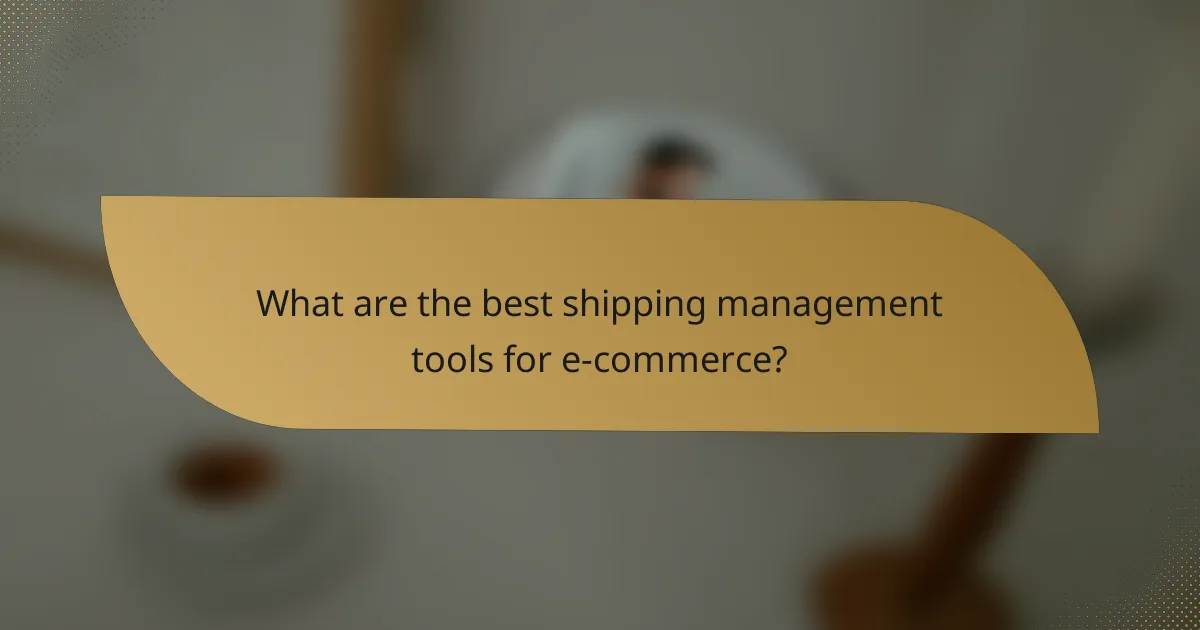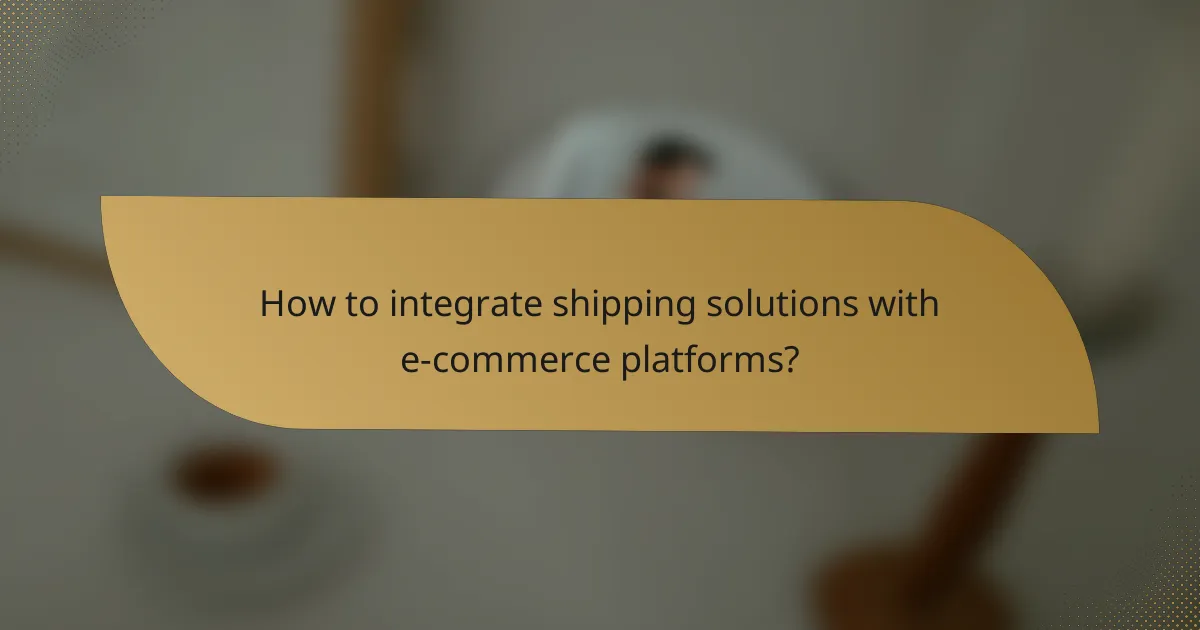In the rapidly evolving world of e-commerce, effective shipping management is crucial for success. Utilizing advanced technology tools and tracking solutions not only streamlines logistics processes but also enhances visibility and efficiency. By integrating these tools, businesses can reduce costs, improve delivery times, and elevate customer satisfaction through real-time updates and seamless operations.

What are the best shipping management tools for e-commerce?
The best shipping management tools for e-commerce streamline the logistics process, enhance tracking capabilities, and integrate seamlessly with online stores. These tools help businesses manage shipping costs, improve delivery times, and provide better customer service.
ShipBob
ShipBob is a popular fulfillment service that offers a comprehensive shipping management solution for e-commerce businesses. It provides warehousing, inventory management, and shipping services, allowing merchants to store their products in ShipBob’s fulfillment centers across various locations.
By using ShipBob, businesses can benefit from reduced shipping costs and faster delivery times. The platform integrates with major e-commerce platforms like Shopify and WooCommerce, making it easy to manage orders and track shipments in real-time.
ShipStation
ShipStation is a versatile shipping software that helps e-commerce businesses manage their shipping processes efficiently. It supports multiple carriers, allowing users to compare rates and choose the best options for their needs.
With features like batch label printing and automated tracking notifications, ShipStation simplifies the shipping workflow. It also integrates with various e-commerce platforms, enabling seamless order management and tracking across different sales channels.
Easyship
Easyship is a shipping platform designed to simplify international shipping for e-commerce businesses. It provides access to a wide range of carriers and shipping options, allowing users to find the most cost-effective solutions for their shipments.
One of the key features of Easyship is its ability to calculate duties and taxes upfront, helping businesses avoid unexpected costs. The platform also offers branded tracking pages, enhancing the customer experience during the shipping process.
ShipHero
ShipHero is a robust shipping and fulfillment solution tailored for e-commerce businesses. It offers inventory management, order fulfillment, and shipping services, all within a single platform. This integration helps streamline operations and reduce errors.
ShipHero’s user-friendly interface allows businesses to manage their shipping processes efficiently, while its real-time analytics provide insights into shipping performance. It also integrates with popular e-commerce platforms, making it easy to sync orders and track shipments.
FedEx Fulfillment
FedEx Fulfillment is a comprehensive logistics solution that combines warehousing, order fulfillment, and shipping services. It is particularly beneficial for businesses looking for reliable shipping options backed by FedEx’s extensive network.
This service allows e-commerce businesses to leverage FedEx’s shipping expertise while managing inventory and fulfillment through a single platform. With various shipping options and real-time tracking, businesses can enhance their customer service and ensure timely deliveries.

How can technology improve shipping efficiency?
Technology enhances shipping efficiency by streamlining processes, reducing errors, and providing real-time visibility. Implementing the right tools can lead to faster deliveries, lower costs, and improved customer satisfaction.
Automated label printing
Automated label printing simplifies the shipping process by generating labels quickly and accurately. This reduces manual errors and speeds up the packing process, allowing for faster dispatch times.
Consider using thermal printers that can handle various label sizes and formats. Integrating label printing software with your order management system can further enhance efficiency by automatically pulling necessary information from orders.
Real-time tracking systems
Real-time tracking systems provide visibility into the shipping process, allowing businesses and customers to monitor packages at every stage. This transparency helps in managing expectations and improving communication.
Using GPS and RFID technology, these systems can offer updates on location and estimated delivery times. Implementing a user-friendly tracking interface can also enhance customer experience, reducing inquiries and complaints.
Inventory management integration
Integrating inventory management with shipping operations ensures that stock levels are accurately reflected in real-time. This prevents overselling and stockouts, which can disrupt shipping schedules.
Utilize software solutions that connect your inventory system with shipping platforms. This integration allows for automatic updates on stock levels and order statuses, streamlining the fulfillment process and improving overall efficiency.
![]()
What are the key tracking solutions for shipments?
Key tracking solutions for shipments include various services that provide real-time updates on package locations and delivery statuses. These solutions enhance visibility and efficiency in shipping management, allowing businesses and consumers to monitor their shipments effectively.
UPS Tracking
UPS Tracking offers a reliable way to monitor packages through its online platform and mobile app. Users can enter their tracking number to receive real-time updates on their shipment’s status, including estimated delivery times and any delays. UPS also provides notifications via email or SMS for added convenience.
For businesses, integrating UPS tracking into their logistics systems can streamline operations and improve customer satisfaction. UPS’s tracking system is known for its accuracy and timely updates, making it a preferred choice for many shippers.
FedEx Tracking
FedEx Tracking allows users to track their shipments with ease, providing detailed information about package locations and delivery progress. By entering a tracking number on the FedEx website or app, customers can view the current status and receive updates on any changes.
FedEx also offers additional features such as delivery alerts and the ability to manage multiple shipments simultaneously. This can be particularly beneficial for businesses that handle a high volume of packages, ensuring they stay informed about their deliveries.
USPS Tracking
USPS Tracking provides a straightforward way to keep tabs on packages sent via the United States Postal Service. Users can track their shipments by entering the tracking number on the USPS website or app, receiving updates on the package’s journey from origin to destination.
USPS tracking is especially useful for domestic shipments and offers features like delivery confirmation and estimated delivery dates. It is a cost-effective solution for individuals and small businesses looking for reliable tracking options.
AfterShip
AfterShip is a comprehensive tracking solution that supports multiple carriers, allowing users to track shipments from various services in one place. This platform provides automated notifications and updates, helping businesses manage their shipping processes more efficiently.
With AfterShip, users can customize their tracking pages and integrate them into their e-commerce platforms. This enhances the customer experience by providing seamless tracking information, which can lead to increased customer satisfaction and loyalty.

How to integrate shipping solutions with e-commerce platforms?
Integrating shipping solutions with e-commerce platforms streamlines order fulfillment and enhances customer satisfaction. Key steps include selecting compatible shipping software, configuring API connections, and ensuring real-time tracking capabilities.
Shopify integration
Shopify offers built-in shipping integrations that simplify the process for merchants. Users can connect with various shipping carriers like UPS, FedEx, and USPS directly through the Shopify dashboard.
To set up, navigate to the ‘Shipping and Delivery’ settings, choose your preferred carriers, and configure rates based on package weight and destination. Consider using apps from the Shopify App Store for advanced features like label printing and automated tracking updates.
WooCommerce integration
WooCommerce allows for flexible shipping solution integrations through plugins. Popular options include WooCommerce Shipping, ShipStation, and Easyship, which enable merchants to manage shipping directly from their WordPress dashboard.
To integrate, install the desired plugin, configure shipping zones, and set rates based on product dimensions and weight. Ensure that your chosen solution supports real-time tracking to keep customers informed about their orders.
Magento integration
Magento provides robust shipping integration options, allowing merchants to connect with multiple carriers and customize shipping workflows. Solutions like Magento Shipping and third-party extensions can enhance functionality.
To integrate, access the ‘Shipping Methods’ section in your Magento admin panel, select your preferred carriers, and set up rules for shipping rates. It’s crucial to test the integration thoroughly to ensure seamless order processing and tracking for customers.

What are the costs associated with shipping management software?
The costs associated with shipping management software can vary significantly based on the features, scale, and specific needs of a business. Generally, businesses should consider monthly subscription fees and transaction fees as the primary cost components.
Monthly subscription fees
Monthly subscription fees for shipping management software typically range from low tens to several hundreds of dollars, depending on the provider and the features included. Basic plans may offer essential functionalities, while premium plans often include advanced features like analytics, reporting, and customer support.
When selecting a subscription plan, evaluate your shipping volume and required features. It’s common for providers to offer tiered pricing based on the number of shipments or users, so choose a plan that aligns with your business size and growth projections.
Transaction fees
Transaction fees are charges incurred for each shipment processed through the software. These fees can vary widely, often ranging from a few cents to several dollars per transaction, depending on the carrier and service level selected.
To manage transaction costs effectively, consider negotiating rates with carriers or choosing software that integrates with multiple shipping options. Be mindful of hidden fees that may arise from additional services like insurance or special handling, which can add up quickly.